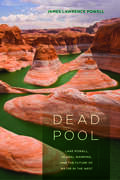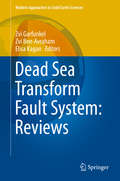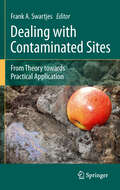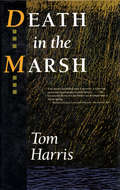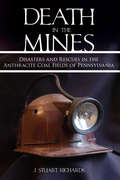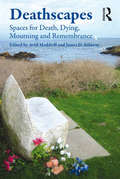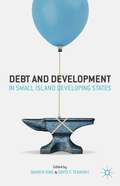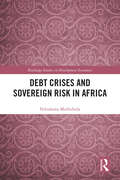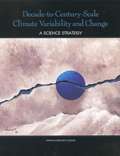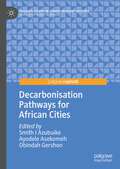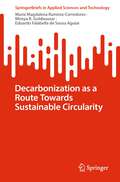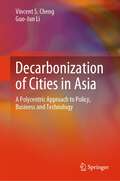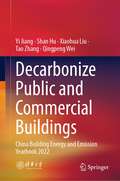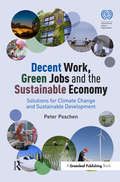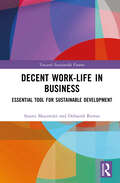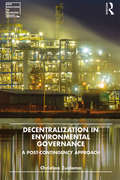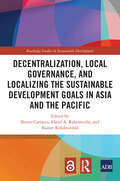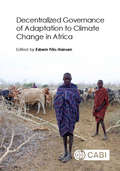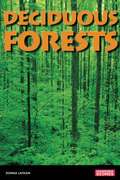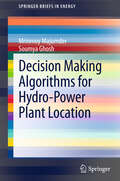- Table View
- List View
Dead Pool: Lake Powell, Global Warming, and the Future of Water in the West
by James Lawrence PowellWhere will the water come from to sustain the great desert cities of Las Vegas, Los Angeles, and Phoenix? In a provocative exploration of the past, present, and future of water in the West, James Lawrence Powell begins at Lake Powell, the vast reservoir that has become an emblem of this story. At present, Lake Powell is less than half full. Bathtub rings ten stories tall encircle its blue water; boat ramps and marinas lie stranded and useless. To refill it would require surplus water—but there is no surplus: burgeoning populations and thirsty crops consume every drop of the Colorado River. Add to this picture the looming effects of global warming and drought, and the scenario becomes bleaker still. Dead Pool, featuring rarely seen historical photographs, explains why America built the dam that made Lake Powell and others like it and then allowed its citizens to become dependent on their benefits, which were always temporary. Writing for a wide audience, Powell shows us exactly why an urgent threat during the first half of the twenty-first century will come not from the rising of the seas but from the falling of the reservoirs.
Dead Sea Transform Fault System: Reviews
by Zvi Garfunkel Zvi Ben-Avraham Elisa KaganThe Dead Sea transform is an active plate boundary connecting the Red Sea seafloor spreading system to the Arabian-Eurasian continental collision zone. Its geology and geophysics provide a natural laboratory for investigation of the surficial, crustal and mantle processes occurring along transtensional and transpressional transform fault domains on a lithospheric scale and related to continental breakup. There have been many detailed and disciplinary studies of the Dead Sea transform fault zone during the last 20 years and this book brings them together. This book is an updated comprehensive coverage of the knowledge, based on recent studies of the tectonics, structure, geophysics, volcanism, active tectonics, sedimentology and paleo and modern climate of the Dead Sea transform fault zone. It puts together all this new information and knowledge in a coherent fashion.
Dead Snails Leave No Trails, Revised: Natural Pest Control for Home and Garden
by Loren Nancarrow Janet Hogan TaylorA practical guide to repelling indoor and outdoor pests using organic methods, updated with new information on getting rid of bedbugs and dust mites, plus includes updated online resources. If you've ever had a swarm of fruit flies in your kitchen or a gopher wreaking havoc in your yard, you may have wondered what a conscientious gardener or homeowner can do short of heavy-duty chemical warfare. Dead Snails Leave No Trails is a comprehensive guide to repelling both indoor and outdoor pests using organic methods--it's the perfect DIY solution to eliminate unwelcome visitors in your home and garden while keeping yourself,your family, and the environment safe from harmful chemicals.With a few easy-to-find items, you'll learn how to: * Make your own all-purpose pest repellents with simple ingredients like chile peppers and vinegar * Use companion planting to attract beneficial insects and animals or repel harmful ones * Keep four-legged intruders--including squirrels, deer, rabbits, and skunks--away from your prized vegetables and flowers * Safely eliminate ants, roaches, and rodents from your house or apartment * Protect your pets from critters like ticks and fleas This revised edition contains newly updated information on today's pest epidemics, like bedbugs, as well as new online resources for finding beneficial organisms that act as predators for specific pests. Full of tips, tricks, and straightforward instructions, Dead Snails Leave No Trails is the most user-friendly guide to indoor and outdoor natural pest solutions.
Dealing with Contaminated Sites
by Frank A. SwartjesThis standard work on contaminated site management covers the whole chain of steps involved in dealing with contaminated sites, from site investigation to remediation. An important focus throughout the book is on Risk Assessment. In addition, the book includes chapters on characterisation of natural and urban soils, bioavailability, natural attenuation, policy and stakeholder viewpoints and Brownfields. Typically, the book includes in-depth theories on soil contamination, along with offering possibilities for practical applications. More than sixty of the world's top experts from Europe, the USA, Australia and Canada have contributed to this book. The twenty-five chapters in this book offer relevant information for experienced scientists, students, consultants and regulators, as well as for 'new players' in contaminated site management
Dealing with Darwin: Place, Politics, and Rhetoric in Religious Engagements with Evolution (Medicine, Science, and Religion in Historical Context)
by David N. LivingstoneHow was Darwin’s work discussed and debated among the same religious denomination in different locations?Using place, politics, and rhetoric as analytical tools, historical geographer David N. Livingstone investigates how religious communities sharing a Scots Presbyterian heritage engaged with Darwin and Darwinism at the turn of the twentieth century. His findings, presented as the prestigious Gifford Lectures, transform our understandings of the relationship between science and religion.The particulars of place—whether in Edinburgh, Belfast, Toronto, Princeton, or Columbia, South Carolina—shaped the response to Darwin’s theories. Were they tolerated, repudiated, or welcomed? Livingstone shows how Darwin was read in different ways, with meaning distilled from Darwin's texts depending on readers' own histories—their literary genealogies and cultural preoccupations. That the theory of evolution fared differently in different places, Livingstone writes, is "exactly what Darwin might have predicted. As the theory diffused, it diverged." Dealing with Darwin shows the profound extent to which theological debates about evolution were rooted in such matters as anxieties over control of education, the politics of race relations, the nature of local scientific traditions, and challenges to traditional cultural identity. In some settings, conciliation with the new theory, even endorsement, was possible—demonstrating that attending to the specific nature of individual communities subverts an inclination to assume a single relationship between science and religion in general, evolution and Christianity in particular. Livingstone concludes with contemporary examples to remind us that what scientists can say and what others can hear in different venues differ today just as much as they did in the past.
Dealing with Socially Responsible Consumers: Studies in Marketing
by Jishnu BhattacharyyaThis book contains a collection of teaching cases that study and emphasise how twenty-first-century businesses address and satisfy the needs and wants of socially conscious consumers while remaining profitable. This book explores the practise of marketing for societal benefit through real-life case studies. It provides a critical understanding of marketing approaches such as social marketing, sustainability marketing, and other practises of a similar nature. This book is made up of both long and short real-life cases from various industries, with varying degrees of difficulty.
Death in the Marsh
by Tom HarrisSelenium, essential in microscopic doses, can be deadly in larger amounts. Death in the Marsh explains how federal irrigation projects have altered selenium's circulation in the environment, allowing it to accumulate in marshes, killing ecosystems and wildlife, and causing deformities in some animals.
Death in the Mines: Disasters and Rescues in the Anthracite Coal Fields of Pennsylvania
by John Stuart RichardsVivid accounts of the dangers that miners faced on a daily basis in the northern, southern, and middle coal fields of eastern Pennsylvania. Since 1870, mining disasters have claimed the lives of over 30,000 men and boys who toiled underground in the anthracite mines of Pennsylvania. Sometimes they survived; many times they did not. The constant threat of fire, explosion, collapsed rock and deadly gas brought miners face to face with death on a daily basis. Through original journal and newspaper accounts, J. Stuart Richards’s Death in the Mines revisits Pennsylvania’s most notorious mining accidents and rescue attempts from 1869 to 1943. From the fire at Avondale Colliery that resulted in the first law for regulation and inspection of mines, to the gas explosion at Lytle Mine in Primrose that killed fourteen men, Richards reveals multiple facets of Pennsylvania’s most perilous profession. Richards, whose family has worked in the mines since 1870, offers a startling yet sensitive tribute to an industry and occupation that is often overlooked and underappreciated.
Death-Facing Ecology in Contemporary British and North American Environmental Crisis Fiction: Ecological Death-facing in Contemporary British and North American Fiction (Routledge Studies in Contemporary Literature)
by Louise SquireRecent years have seen a burgeoning of novels that respond to the environmental issues we currently face. Among these, Louise Squire defines environmental crisis fiction as concerned with a range of environmental issues and with the human subject as a catalyst for these issues. She argues that this fiction is characterized by a thematic use of "death," through which it explores a "crisis" of both environment and self. Squire refers to this emergent thematic device as "death-facing ecology". This device enables this fiction to engage with a range of theoretical ideas and with popular notions of death and the human condition as cultural phenomena of the modern West. In doing so, this fiction invites its readers to consider how humanity might begin to respond to the crisis.
Deathscapes: Spaces for Death, Dying, Mourning and Remembrance
by James D. SidawayDeath is at once a universal and everyday, but also an extraordinary experience in the lives of those affected. Death and bereavement are thereby intensified at (and frequently contained within) certain sites and regulated spaces, such as the hospital, the cemetery and the mortuary. However, death also affects and unfolds in many other spaces: the home, public spaces and places of worship, sites of accident, tragedy and violence. Such spaces, or Deathscapes, are intensely private and personal places, while often simultaneously being shared, collective, sites of experience and remembrance; each place mediated through the intersections of emotion, body, belief, culture, society and the state. Bringing together geographers, sociologists, anthropologists, cultural studies academics and historians among others, this book focuses on the relationships between space/place and death/ bereavement in 'western' societies. Addressing three broad themes: the place of death; the place of final disposition; and spaces of remembrance and representation, the chapters reflect a variety of scales ranging from the mapping of bereavement on the individual or in private domestic space, through to sites of accident, battle, burial, cremation and remembrance in public space. The book also examines social and cultural changes in death and bereavement practices, including personalisation and secularisation. Other social trends are addressed by chapters on green and garden burial, negotiating emotion in public/ private space, remembrance of violence and disaster, and virtual space. A meshing of material and 'more-than-representational' approaches consider the nature, culture, economy and politics of Deathscapes - what are in effect some of the most significant places in human society.
Debt And Development In Small Island Developing States
by Damien King David F. TennantDebt and Development in Small Island Developing States draws on the expertise of established researchers and public officials from within the SIDS community to answer the following pressing questions related to sustainability, debt accumulation, and prospects for future growth.
Debt Crises and Sovereign Risk in Africa (Routledge Studies in Development Economics)
by Ndzalama MathebulaThis book examines the resurgence of debt crises in Africa following the Covid-19 pandemic. It deciphers the debt crisis phenomenon through the discourse of sovereign risk, which has been paid insufficient attention within the African context. It seeks to appreciate facets that continue to lead African states to a debt-default position.The book focuses on the pre-stages of default and debt default risks. It explores and investigates whether South Africa was and continues to be financially capable of servicing its International Monetary Fund (IMF) loan, granted in 2020 for the COVID-19 pandemic. While investigating how and why Ethiopia and Ghana have already defaulted on their post-pandemic loans from the IMF. It examines the idea of sovereign risk in Africa through a qualitative methodology and a case study research design, analyzing three countries borrowed from the IMF in 2020 or later, mainly prompted by the pandemic. The book distinguishes between African states that have not yet defaulted and those that have already defaulted on their debt servicing. Namely, South Africa, Ethiopia, and Ghana, two of which have already defaulted on their loan. The book also notes the resurgence of the IMF within the African continent while assessing the past narrative and impact of the international monetary system and how it has changed in the post-pandemic era. However, economic diversification has been noted as a prominent remedy that holds the potential of strengthening African economies and aiding their eradication of the debt crisis.The book is designed to appeal to numerous reading communities, namely scholars, researchers, advanced students and policymakers.
Decade-to-Century-Scale Climate Variability and Change: A Science Strategy
by Panel on Climate Variability on Decade-to-Century Time ScalesSociety today may be more vulnerable to global-scale, long-term, climate change than ever before. Even without any human influence, past records show that climate can be expected to continue to undergo considerable change over decades to centuries. Measures for adaption and mitigation will call for policy decisions based on a sound scientific foundation. Better understanding and prediction of climate variations can be achieved most efficiently through a nationally recognized "dec-cen" science plan. This book articulates the scientific issues that must be addressed to advance us efficiently toward that understanding and outlines the data collection and modeling needed.
Decarbonisation Pathways for African Cities (Palgrave Studies in Climate Resilient Societies)
by Smith I Azubuike Ayodele Asekomeh Obindah GershonThis book examines the pathways to decarbonising African cities, structured around strategies and applications in renewable energy, waste management, healthcare, telecommunication, education and governance reconfigurations for Petro-cities. Throughout the book the authors highlight infrastructural, governance and policy approaches to drive decarbonisation. Opening with chapters focused on propositions for solar urban planning and scope for decarbonisation in waste management the book then moves on to examine innovative strategies for a low-carbon healthcare sector. The authors then discuss the use of hybrid power systems at remote telecommunication sites, their deployment on university campuses, and how this can be optimised to reduce carbon emissions. Further chapters explore government, private sector and civil society actions for decarbonising Kenyan cities and an overview of the political economic choices for decarbonising Petro-cities. Finally, closing chapters propose mechanisms for translating COP26 takeaways to decarbonisation policies and a low-carbon framework for African cities.
Decarbonization as a Route Towards Sustainable Circularity (SpringerBriefs in Applied Sciences and Technology)
by Maria Magdalena Ramirez-Corredores Mireya R. Goldwasser Eduardo Falabella de Sousa AguiarThis book surveys the current research on CO2 conversion processes and shows that these can close the carbon cycle as part of a circular economy. The technical and economic feasibility of these processes are examined together and current scientific challenges are signposted, which will guide future R&D. Technology sustainability is key for meeting and keeping decarbonization goals in the long term. However, considering economic and environmental sustainability individually is not enough. An integral view of sustainability that incorporates an energy term in the equation is needed. This book brings this concept to the fore.
Decarbonization of Cities in Asia: A Polycentric Approach to Policy, Business and Technology
by Vincent S. Cheng Guo-Jun LiThis book provides best practices for decarbonizing cities in East Asia, in which buildings are the major contributor to carbon emissions. Beyond the global commitment through the Paris Agreement to make collective efforts on climate action and accelerated policies, investment and development at the country and city level to combat climate change are occurring at an unprecedented rate. Rapid urbanization and increasing energy demand for large and dense Asian cities require smart and sustainable strategies to balance development with decarbonization. A poly-centric approach is needed, where a combination of policy-, market- and technology-driven changes can aid the transition towards development of carbon neutral cities. With practical examples in the implementation of the United Nations Sustainable Development Goals, green financing, climate action roadmap and policy, deployment of renewable energy, and low- to zero-carbon buildings, readers can find the motivation, considerations and implementation pathways to facilitate the transition into the new normal. It is the hope of the authors to encourage readers to see successful pathways in transitioning into a carbon-free industry and overcoming the effects of climate extremes.
Decarbonize Public and Commercial Buildings: China Building Energy and Emission Yearbook 2022
by Tao Zhang Xiaohua Liu Yi Jiang Shan Hu Qingpeng WeiOne of the key motivations and goals for China's social and economic development is the dual carbon target. Building is one of the most important sectors to reduce emissions and save energy, accounting for more than 20% of China's primary energy consumption and carbon emissions. This book analyzes the energy consumption of China's buildings sector in four categories, their characteristics and technologies to improve energy efficiency, and examines the greenhouse gas emissions of China's buildings, including building construction embodied emission and building operation emissions. In particular, this book discusses the ways to achieve carbon neutrality targets for China's public and commercial building sectors. This book also analyzes the energy mix, energy intensity, and technological prospects for achieving energy and carbon targets in the public and commercial building sectors. This book contains a large amount of survey data, monitoring data, and case studies. The debate on technologies and policies is underpinned by a variety of evidence and research that has been ongoing for more than a decade. The information, data, and policy recommendations will be of interest to a national and international audience working in the fields of energy, climate change, engineering, and building science.
Decent Work, Green Jobs and the Sustainable Economy: Solutions for Climate Change and Sustainable Development
by Peter PoschenThe challenges of achieving environmental sustainability and of generating decent work for all are closely linked. In this timely book, Poschen argues that an integrated approach to tackle these challenges is a necessity: the goal of environmentally sustainable economies will not be attained without the active contribution of the world of work. Decent Work, Green Jobs and the Sustainable Economy demonstrates that green jobs can be a key economic driver, as the world steps into the largely uncharted territory of building a sustainable and low-carbon global economy. Poschen shows that positive outcomes are possible, but require a clear understanding of the opportunities and challenges.Enterprises, workers and governments are not passive bystanders in the great transformation that is urgently needed in our economies. They are essential agents of change, able to develop new ways of working in sustainable enterprises that safeguard the environment, create decent jobs and foster social inclusion. This book highlights the solutions that the world of work offers for policy and practice to tackle climate change, achieve environmental sustainability and to build prosperous and cohesive societies. It is essential reading for those in business, academia and government.
Decent Work-Life in Business: Essential Tool for Sustainable Development (Towards Sustainable Futures)
by Debasish Biswas Soumi MajumderDecent Work-Life in Business: Essential Tool for Sustainable Development presents a detailed discussion of the concept of decent work-life and its application in business for sustainable development. It discusses decent work-life culture in a business environment. The book makes a strong case for decent work, which not only provides work opportunities but also delivers a fair income, fair treatment, security at the workplace, and social protection for families. With the help of empirical data and statistical indicators, it explores themes such as: ILO and decent work agenda opportunities for work and dignity at work social dimensions of globalization and sustainable development poverty reduction through decent work work-life balance and social protection unacceptable work and social dialogue economic and social context of decent work This book will be an indispensable resource for the students, scholars and teachers of business management and especially those pursuing a career in human resource management. It will also interest scholars of political economy, sociology of work, business management, human resource management, labour studies, public policy, and social anthropology alongside industry experts.
Decentralization in Environmental Governance: A post-contingency approach (New Directions in Planning Theory)
by Christian ZuidemaDecentralization in Environmental Governance is a critical reflection on the dangers and risks of governance renewal; warning against one-sided criticism on traditional command and control approaches to planning. The book formulates the arguments that support when and how governance renewable might be pursued, but this attempt is not just meant for practitioners and scholars interested in governance renewal. It is also useful for those interested in the challenge of navigating a plural landscape of diverse planning approaches, which are each rooted in contrasting theoretical and philosophical positions. The book develops a strategy for making argued choices between alternative planning approaches, despite their theoretical and philosophical positions. It does so by revitalizing the idea that we can contingently relate alternative planning approaches to the circumstances encountered. It is an idea traced to contingency studies of the mid and late 20th century, reinterpreted here within a planning landscape dominated by notions of uncertainty, complexity and socially constructed knowledge. This approach, called ‘Post-contingency’, is both a theoretical investigation of arguments for navigating the theoretical plurality we face and an empirical study into renewing environmental governance. Next to its theoretical ambitions, Decentralization in Environmental Governance is practical in offering a constructive critique on current processes of governance renewal in European environmental governance.
Decentralization, Local Governance, and Localizing the Sustainable Development Goals in Asia and the Pacific (Routledge Studies in Sustainable Development)
by Bruno Carrasco, Hanif A. Rahemtulla, and Rainer RohdewohldSince its adoption in 2015, the 2030 Agenda on Sustainable Development has shaped not only international development cooperation but also the design of national trajectories for social and economic development. In tandem with other global agendas adopted that year (such as the Paris Agreement on Climate Change and UN Habitat’s New Urban Agenda) it remains the global and regional blueprint for sustainable development despite the COVID-19 pandemic. The term "localizing the Sustainable Development Goals (SDGs)" has been used to capture the importance of subnational governments for achieving national SDG agendas. However, there is little deeper analysis of the required nexus between fiscal, political, and legal arrangements for SNGs; their involvement in national policy arenas (which discuss and decide on national SDG strategies); and the need for locally disaggregated data systems on the one hand, and effective SDG localization strategies on the other hand. It is this aspect which the present publication explores in greater detail by using country examples and conceptual analyses. The text will be of interest to policymakers, scholars, students and practitioners in public policy and public administration, decentralization, and sustainable development, with a focus on the Asia and Pacific region. The Open Access version of this book, available at www.taylorfrancis.com, has been made available under a Creative Commons Attribution-Non-Commercial-No Derivative License (CC BY-NC-ND 3.0 IGO).
Decentralized Governance of Adaptation to Climate Change in Africa
by Esbern Friis-Hansen Charles Aben Professor Jacob Agea Bernard Bashaasha Sarah Ann D'Haen Mikkel Funder Carol Mweemba Isaac Nakendo Jonas Østergaard Nielsen Professor Imasiku Nyambe James Okiror Julie Fogt Rasmussen Godfrey SuubiTwo perspectives have dominated the social science discourse on climate change adaptation. Firstly, an international narrative among UN and donor agencies of technical and financial support for planned climate change adaptation. Secondly, a significant volume of studies discuss how local communities can undertake their own autonomous adaptation. Effective and sustainable climate adaptation requires a third focus: understanding of the political processes within sub-national institutions that mediate between national and local practices. This book address the knowledge gap that currently exists about the role of district-level institutions in Sub-Saharan Africa in providing an enabling institutional environment for rural climate change adaptation. Key Features: · Analyses the disconnect between national and local policy and practice, and how to overcome it · Analysis of the political ecology of climate change adaptation in 10 diverse rural districts across Sub-Saharan Africa based on evidence from thorough field work · Explains how to improve the efficiency and effectiveness of climate change adaptation programmes by engaging with decentralized local governments and principles of subsidiarity with regards to decision-making and control over financial resources
Decentralized Governance of Adaptation to Climate Change in Africa
by Esbern Friis-HansenTwo perspectives have dominated the social science discourse on climate change adaptation. Firstly, an international narrative among UN and donor agencies of technical and financial support for planned climate change adaptation. Secondly, a significant volume of studies discuss how local communities can undertake their own autonomous adaptation. Effective and sustainable climate adaptation requires a third focus: understanding of the political processes within sub-national institutions that mediate between national and local practices. This book address the knowledge gap that currently exists about the role of district-level institutions in Sub-Saharan Africa in providing an enabling institutional environment for rural climate change adaptation. Key Features: #65533; Analyses the disconnect between national and local policy and practice, and how to overcome it #65533; Analysis of the political ecology of climate change adaptation in 10 diverse rural districts across Sub-Saharan Africa based on evidence from thorough field work #65533; Explains how to improve the efficiency and effectiveness of climate change adaptation programmes by engaging with decentralized local governments and principles of subsidiarity with regards to decision-making and control over financial resources
Deciduous Forests
by Donna LathamInvestigating the planet's biomes and examining the modern threats to each ecosystem, this interactive series challenges young readers to look at how their own actions influence the planet's health. With compare-and-contrast facts and vocabulary-building sidebars, each engaging guide reveals how environmental threats-both human and natural-affect plants and animals.Showcasing the diverse woodland of deciduous forests, this resource reveals how many of its threats come from humans. Covering topics such as deforestation, acid rain, disease, and invasive species, this engaging guide shows how, in the complicated web of life in the forest, even natural threats can be made worse by human activity.
Decision Making Algorithms for Hydro-Power Plant Location
by Mrinmoy Majumder Soumya GhoshThe present study has attempted to apply the advantage of neuro-genetic algorithms for optimal decision making in maximum utilization of natural resources. Hydro-power is one of the inexpensive, but a reliable source of alternative energy which is foreseen as the possible answer to the present crisis in the energy sector. However, the major problem related to hydro-energy is its dependency on location. An ideal location can produce maximum energy with minimum loss. Besides, such power-plant also requires substantial amount of land which is a precious resource nowadays due to the rapid and uncontrolled urbanization observed in most of the urban centres in the World. The feasibility of such plants also depends on social acceptance as well as the level of environmental casualty and economic benefit, all of which is also spatially dependent. Decision making algorithms are applied to identify better solution if a problem has more than one alternative explication. Nature based algorithms are found to be efficient enough to catalyze such kind of decision making analysis. That is why the present study tries to utilize nature based algorithms to solve the problems of location selection for hydropower plants. The study employed six different types of nature based algorithms to select one of the locations among many available for installation of hydropower plant in the North Eastern part of the Indian subcontinent. The locations are selected based on their in stream resources and included in the decision making as alternatives. A methodology of criteria selection, determination of weightage and applications of bioinspired algorithms are adopted to produce utmost exertion of the available natural resources with minimum hostility and wastage of the same.
